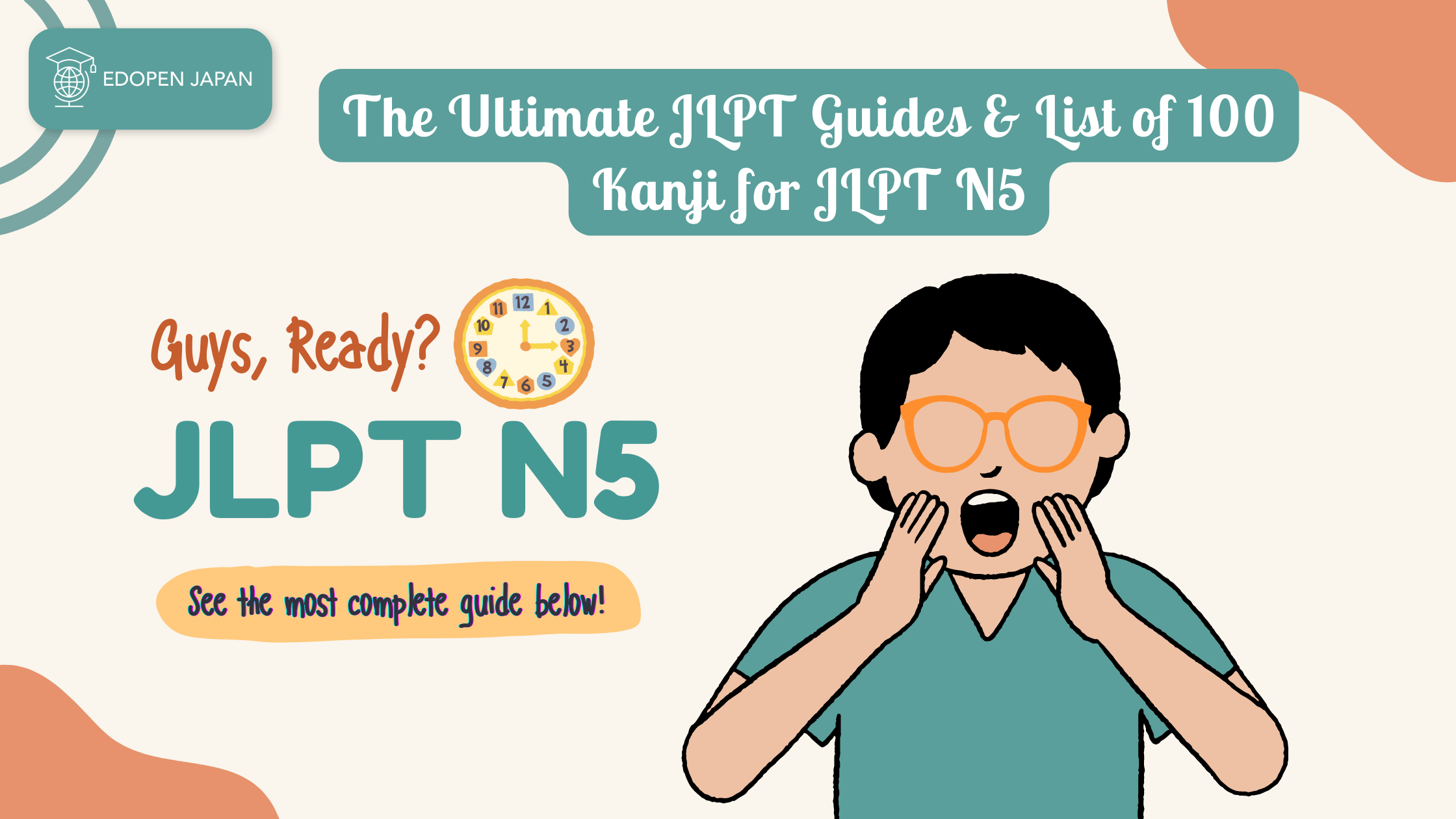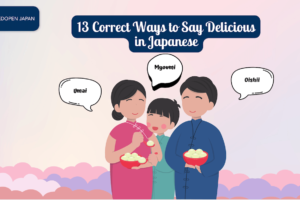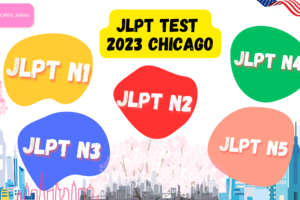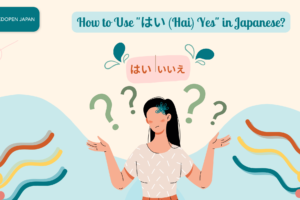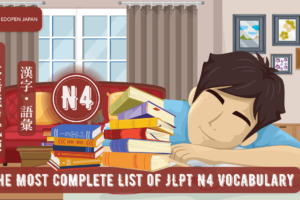If you are considering taking a Japanese language exam to evaluate your skills, the JLPT would be a great choice. More than 1 million people take this test every year. People take the JLPT to measure their own level of proficiency, to get a job, to get a raise, to get a promotion, or for admission/graduation to educational institutions.
This article provides general information about the JLPT, including background information about the JLPT, a brief introduction to N1~N5, information about the 2022 test, and finally how to prepare for the JLPT N5. In addition, a list of 100 kanji needed for the N5 test can be found in the last part of this article. Don’t forget to check it out!
Please also check out our other special JLPT and JLPT N5-related article recommendations below!
Read also:
700+ JLPT N5 Vocabulary | The Most Complete Lists
JLPT: A Complete Guide to the Differences Between Levels N1-N5
Contents
What is the JLPT (日本語能力試験)?
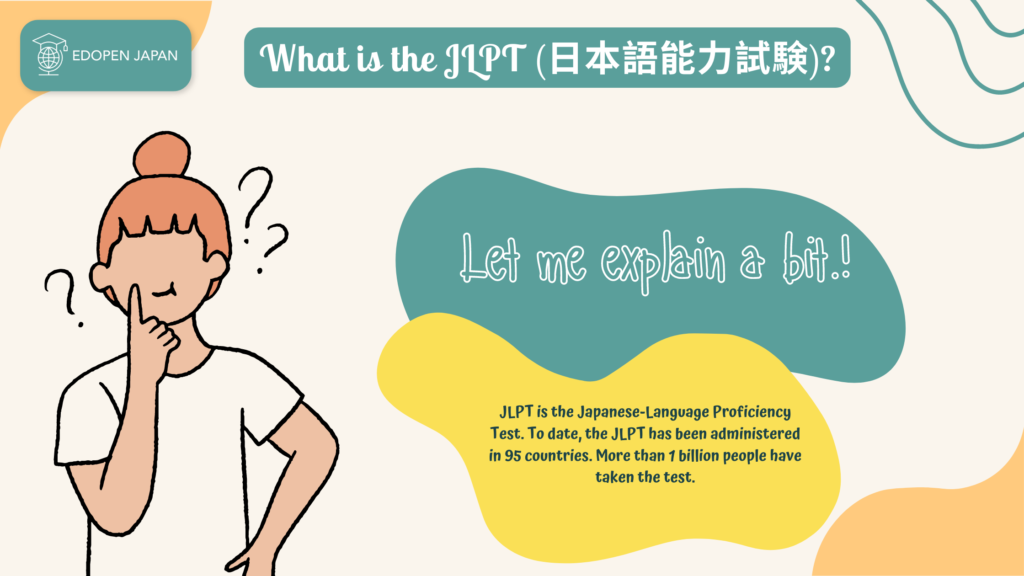
JLPT is the abbreviation for “Japanese-Language Proficiency Test”, the Japanese name of which is 日本語能力試験 (ni-hon-go-nō-ryoku-shi-ken). This test was established in 1984 by the Japan Foundation and Japan Educational Exchanges and Services (JEES).
The JLPT was first administered in only 15 countries and only about 7,000 people took the test. To date, the exam has been administered in approximately 95 countries and territories around the world. Even in 2017, the number of JLPT registrations is over 1 million. The number of test-takers has grown significantly year after year.
People can take the test not only in Japan, but also in many other countries across North America, Latin America, Oceania, East Asia, South Asia, Southeast Asia, Eastern Europe, Western Europe, Middle East, Africa, and North Africa. (Click the link for the list of the countries!)
What can you do with JLPT certification?
In recent years, there are over one million people around the world who have applied for this test. There are 5 main benefits to obtaining a JLPT certificate.
◉ It is for those who have an immigration plan to Japan
◉ For those who want to require a Japanese medical license / take an assistant nurse exam
◉ Who is seeking a job position in Japan
◉ Definitely for those who want to evaluate their Japanese ability
5 Levels of JLPT
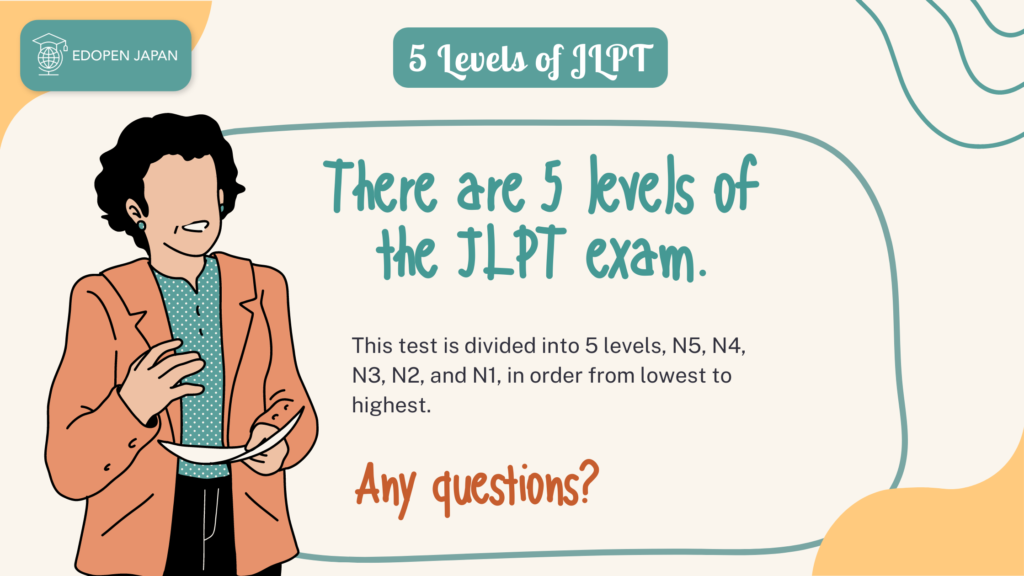
This test is divided into 5 levels, N5, N4, N3, N2, and N1, in order from lowest to highest. There is no requirement to take or pass a lower level in order to take a higher-level test. In this case, you can apply to take the test at any level.
At all levels, the main sections to test include the following:
- Language Knowledge(Vocabulary / Grammar): 言語知識(文字・語彙 / 文法)
- Reading: 読解
- Listening: 聴解
All questions are multiple-choice. There is no oral or written test for all levels of the JLPT.
N5
◉ Linguistic competence required: The ability to understand some basic Japanese.
◉ Overall pass marks / full marks: 80 / 180 points
| Test sections | Language Knowledge (Vocabulary / Grammar)・Reading | Listening |
|---|---|---|
| Test time | ① Language Knowledge (Vocabulary): 20 min ② Language Knowledge (Grammar)・Reading: 40 min | ③ 30 min |
| Sectional pass mark / full mark | 38 / 120 points | 19 / 60 points |
❝ Check the 100 KANJI LIST for N5 in the LAST section of this article! ❞
N4
◉ Linguistic competence required: The ability to understand basic Japanese.
◉ Overall pass marks / full marks: 90 / 180 points
| Test sections | Language Knowledge (Vocabulary / Grammar)・Reading | Listening |
|---|---|---|
| Test time | ① Language Knowledge (Vocabulary): 25 min ② Language Knowledge (Grammar)・Reading: 55 min | ③ 35 min |
| Sectional pass mark / full mark | 38 / 120 points | 19 / 60 points |
N3
◉ Linguistic competence required: The ability to understand Japanese used in everyday situations to a certain degree.
◉ Overall pass marks / full marks: 95 / 180 points
| Test sections | Language Knowledge (Vocabulary / Grammar)・Reading | Listening |
|---|---|---|
| Test time | ① Language Knowledge (Vocabulary): 30 min ② Language Knowledge (Grammar)・Reading: 70 min | ③ 40 min |
| Sectional pass mark / full mark | Language Knowledge (Vocabulary / Grammar): 19 / 60 points Reading: 19 / 60 points | 19 / 60 points |
N2
◉ Linguistic competence required: The ability to understand Japanese used in everyday situations, and in a variety of circumstances to a certain degree.
◉ Overall pass marks / full marks: 90 / 180 points
| Test sections | Language Knowledge (Vocabulary / Grammar)・Reading | Listening |
|---|---|---|
| Test time | 105 min | 50 min |
| Sectional pass mark / full mark | Language Knowledge (Vocabulary / Grammar): 19 / 60 points Reading: 19 / 60 points | 19 / 60 points |
N1
◉ Linguistic competence required: The ability to understand Japanese used in a variety of circumstances.
◉ Overall pass marks / full marks: 100 / 180 points
| Test sections | Language Knowledge (Vocabulary / Grammar)・Reading | Listening |
|---|---|---|
| Test time | 110 min | 60 min |
| Sectional pass mark / full mark | Language Knowledge (Vocabulary / Grammar): 19 / 60 points Reading: 19 / 60 points | 19 / 60 points |
How to Register for JLPT?

Who can take the JLPT?
The JLPT is a test designed for non-native speakers of Japanese to assess their level of proficiency. In this case, even if you already have Japanese citizenship, it is possible to take the test as a non-native speaker! There is also no age limit for registration.
When is JLPT 2022?
In general, JLPT is held twice a year, in early July and December. More specifically, JLPT is usually held on the first Sunday of July and December.
❖ Taking in Japan
- Test information releasing: (First test) around early February and (Second test) around early July.
- Registration period (Online only): (First test) from late March to mid-April and (Second test) from late August to mid-September.
- Receive test voucher: (First test) mid-June and (Second test) mid-November.
- Test results released: (First test) early September and (Second test) early February.
Test Fee: 6,500 JPY (consumption tax included)
| Test Date | Registration | Test voucher | Test Results | |
|---|---|---|---|---|
| First test | Sunday, Jul. 3 | Mar. 25 ~ Apr. 15 at 5 PM JST | Jun. 17 | the end of August 2022 |
| Second test | Sunday, Dec. 4 | Aug. 25 ~ Sep.15 at 5 PM JST | Nov. 18 | the end of January 2023 |
More information: https://info.jees-jlpt.jp/info/
❖ Taking in the United States
Test Fee: 100 USD
JLPT in the United States is held by the American Association of Teachers of Japanese (AATJ). There is no July test in the United States. Information on test locations will be released in May or June of 2022. You can find the latest registration information here: https://www.aatj.org/jlpt
| Test Date | Registration | Test Results | |
|---|---|---|---|
| First | – | – | – |
| Second | Dec. 4 | N1: From August 10, at 9:00 AM Pacific time N2: Form August 12, at 9:00 AM Pacific time N3: From August 15, at 9:00 AM Pacific time N4: From August 17, at 9:00 AM Pacific time N5: From August 19, at 9:00 AM Pacific time N1~N5 application end on September 13, at 5:00 PM Pacific time | around March 2023 |
❖ Taking in other countries or areas
- Some countries/cities only held one test (July or December) each year.
- Depending on the countries there will be different registration periods and the date of the result. Check this site for the information on the area you are going to take JLPT: https://www.jlpt.jp/e/application/overseas_list.html
💡 Due to the spread of the novel coronavirus disease (COVID-19), remember to check the official website for the latest news on JLPT!
How to Prepare for the JLPT N5 Test?

After a long introduction of information about the JLPT, let’s take a look at the types of questions that will appear on the JLPT N5 test and the suggestions for each section!
💡 Language Knowledge (Vocabulary):
Make sure you are familiar with all hiragana, katakana, and basic kanji. In the vocabulary test section, you will be given some questions that require you to simply choose the correct hiragana for katakana or kanji words. This would be comparatively easy with other sections, which might be regretful to lose points here! Check my other article for the hiragana, katakana, romaji chart, and download it to practice.
✎ Choose the correct hiragana for a kanji/katakana word given in the question.
✎ Select the most proper word to complete the given sentence in the question.
✎ Choose the option that possesses the closest meaning to the given sentence in the question.
💡 Language Knowledge (Grammar)・Reading:
After learning the grammar needed for N5, it is suggested that you make sentences using that grammar. In this case, you can make sure that the usage is correct or not. It is also helpful to remember the grammar of your own sentence.
As for the reading section, when you do the practice workbook, pay attention to whether you are spending too much time reading. If so, make sure you improve your reading speed before the test!
✎ Choose the correct particle that best fits into the given sentence in the question
✎ While there will be 4 consecutive blanks in a sentence, you need to construct the sentence with the 4 options given and choose the correct option for the designated blank.
✎ You can pick the correct word that can best fit into the blank in an article.
✎ Choose the correct option for the question, according to the given article.
💡 Listening
In this section, the conversations you hear are about everyday situations. In addition to more practice before the test, make sure you have the ability to absorb the necessary information.
✎ Choose the best option for the given question according to the description or conversation you heard.
100 Kanji List of JLPT N5
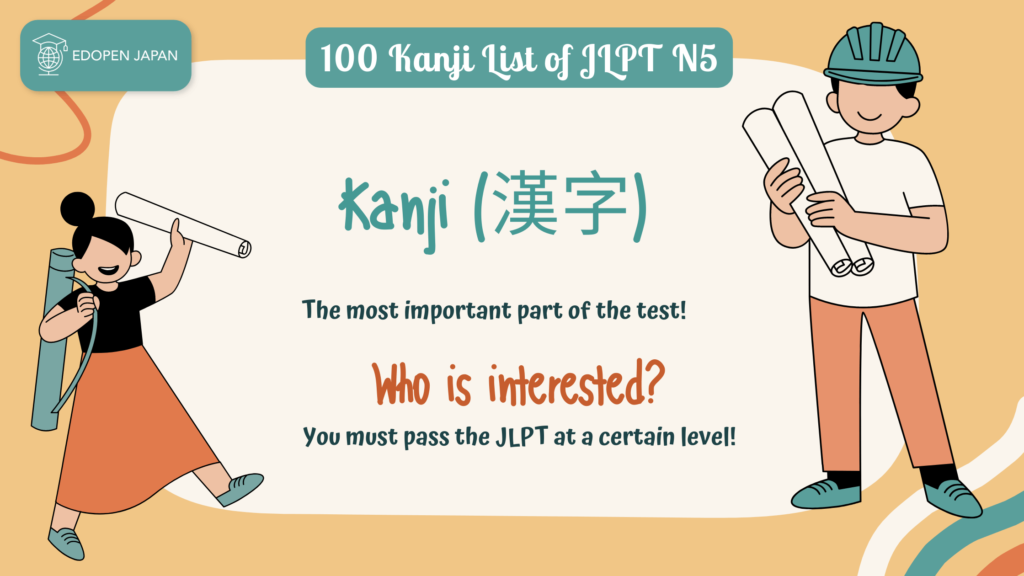
Number & Time
| Kanji | English | Onyomi | Kunyomi | Word | Rōmaji | English |
|---|---|---|---|---|---|---|
| 一 | one | ichi / itsu | hi-to / hito-tsu | 一日 | tsuitachi | 1st day of the month |
| 二 | two | ni | fu-ta / futa-tsu | 二日 | futsu-ka | 2nd day of the month |
| 三 | three | san | mi / mit-tsu | 三日 | mikka | 3rd day of the month |
| 四 | four | shi | yo / yo-tsu / yottsu / yon | 四日 | yokka | 4th day of the month |
| 五 | five | go | itsu / itsu-tsu | 五日 | itsu-ka | 5th day of the month |
| 六 | six | roku | mu / mu-tsu / muttsu / mui | 六日 | mui-ka | 6th day of the month |
| 七 | seven | shichi | nana / nana-tsu / nano | 七日 | nano-ka | 7th day of the month |
| 八 | eight | hachi | ya / ya-tsu / yattsu / yō | 八日 | yō-ka | 8th day of the month |
| 九 | nine | kyuu / ku | kokono / kokono-tsu | 九日 | kokono-ka | 9th day of the month |
| 十 | ten | jū / ji | too / to | 十日 | too-ka | 10th day of the month |
| 百 | hundred | hyaku | – | 百円 | hyaku-man | one hundred yen |
| 千 | thousand | sen | chi | 千円 | sen-en | one thousand yen |
| 万 | ten thousand | man / ban | – | 一万円 | ichi-man-en | ten thousand yen |
| 円 | yen | en | maru | 三十円 | san-jū-en | thirty yen |
| 年 | year | nen | toshi | 今年 | ko-toshi | this year |
| 月 | month | getsu / gatsu | tsuki | 来月 | rai-getsu | next month |
| 日 | day | nichi / chitsu | hi / ka | 毎日 | mai-nichi | everyday |
| 週 | week | shū | – | 三週間 | san-shū-kan | three weeks |
| 曜 | shining / day of week | yō | – | 月曜日 | getsu-yō-bi | Monday |
| 火 | fire | ka | hi / ho | 火曜日 | ka-yō-bi | Tusesday |
| 水 | water | sui | mizu | 水曜日 | sui-yō-bi | Wednesday |
| 木 | wood | boku / moku | ki / ko | 木曜日 | moku-yō-bi | Thursday |
| 金 | gold | kin / kon | kane / kana | 金曜日 | kin-yō-bi | Friday |
| 土 | soil | do / to | tsuchi | 土曜日 | do-yō-bi | Saturday |
| 時 | time / hour | ji | toki | 時間 | ji-kan | time |
| 分 | minutes | fun / bun / bu | wa | 五分 | go-fun | five minutes |
| 秒 | second | byō | – | 六秒 | roku-byō | six seconds |
| 今 | now / today | kon / kin | ima | 今日 | kyō | today |
| 昨 | last / yesterday | saku | kinō | 昨日 | kinō | yesterday |
| 明 | tomorrow | mei / myō | a / aka | 明日 | ashita | tomorrow |
| 先 | previous / last | sen | saki | 先月 | sen-getsu | last month |
| 何 | what | ka | nani / nan | 何時? | nan-ji | What time? (hour) |
Direction
| Kanji | English | Onyomi | Kunyomi | Word | Rōmaji | English |
|---|---|---|---|---|---|---|
| 上 | up | jō / shō | ue / uwa / kami / a / nobo | 山の上 | yama-no-ue | on the moutain |
| 下 | down | ka / ge | shita / shimo / moto / sa / kuda / o | 箱の下 | hako-no-shita | under the box |
| 左 | left | sa | hidari | 左手 | hidari-te | left hand |
| 右 | right | u / yū | migi | 右手 | migi-te | right hand |
| 前 | front / (time) ago | zen | mae | 家の前 | ie-no-mae | in front of home |
| 後 | back / (time) later | go / kō | nochi / ushi / ato / oku | 後ろの席 | ushiro-no-seki | seat in the back |
| 中 | inside | chū / jū | naka | 箱の中 | hako-no-naka | in the box |
| 内 | inside | nai / dai | uchi | 教室内 | kyō-shitsu-nai | in the classroom |
| 外 | outside | gai / ge | soto / hoka / hazu | 外の人 | soto-no-hito | the person outside |
Human & Body
| Kanji | English | Onyomi | Kunyomi | Word | Rōmaji | English |
|---|---|---|---|---|---|---|
| 男 | male | dan / nan | otoko | 男性 | dan-sei | male |
| 女 | female | jo / nyo | onna / me | 女性 | jo-sei | female |
| 父 | father | fu | chichi | 父親 | chi-chi-oya | father |
| 母 | mother | bo | haha | 母親 | ha-ha-oya | mother |
| 夫 | husband | fū | otto | |||
| 妻 | wife | sai | tsuma | |||
| 兄 | oder brother | kei | ani | |||
| 姉 | older sister | shi | ane | |||
| 弟 | younger brother | tei | otōto | |||
| 妹 | yonger sister | mai | imōto | |||
| 体 | body | tai / tei | karada | |||
| 頭 | head | tō / zu / to | atama / kashira | |||
| 髪 | hair | hatsu | kami | |||
| 顔 | face | gan | kao | |||
| 手 | hand | shu | te / ta | |||
| 足 | foot | soku | ashi / ta |
Color
| Kanji | English | Onyomi | Kunyomi | Word | Rōmaji | English |
|---|---|---|---|---|---|---|
| 白 | white | haku / byaku | shiro / shira | 白い | shiro-i | white |
| 黒 | black | koku | kuro | 黒い | kuro-i | black |
| 赤 | red | seki / shaku | aka | 赤い | aka-i | red |
| 黄 | yellow | kō | ki / ko | 黄色い | ki-iro-i | yellow |
| 青 | blue | sei / shō | ao | 青い | ao-i | blue |
| 暗 | dark | an | kura | 暗い | kura-i | dark |
Adjective
| Kanji | English | Onyomi | Kunyomi | Word | Rōmaji | English |
|---|---|---|---|---|---|---|
| 大 | big | dai / tai | ō | 大きい | ō-kī | big |
| 小 | small | shō | chī / ko / o | 小さい | chīsai | small |
| 太 | thick | tai / ta | futo | 太い | futo-i | thick |
| 細 | thin | sai | hoso / koma | 細い | hoso-i | thin |
| 長 | long | chō | naga | 長い | naga-i | long |
| 短 | short | tan | mijika | 短い | mijika-i | short |
| 高 | expensive / tall | kō | taka | 高い | taka-i | expensive / tall |
| 安 | cheap | an | yasu | 安い | yasu-i | cheap |
| 低 | short | tei | hiku | 低い | hiku-i | short |
| 良 | good | ryō | yo | 良い | yo-i | good |
| 悪 | bad | aku / o | waru | 悪い | waru-i | bad |
| 早 | early | sō / sa | haya | 早い | haya-i | early |
| 遅 | late | chi | oku / oso | 遅い | oso-i | late |
| 新 | new | shin | atara / ara / nii | 新しい | atara-shī | new |
| 古 | old | ko | furu | 古い | furu-i | old |
| 暑 | (weather) hot | sho | atsu | 暑い | atsu-i | (weather) hot |
| 寒 | (weather) cold | ka | samu | 寒い | samu-i | (weather) cold |
Verb
| Kanji | English | Onyomi | Kunyomi | Word | Rōmaji | English |
|---|---|---|---|---|---|---|
| 聞 | listen | bun / mon | ki | 聞く | ki-ku | listen |
| 見 | see | ken | mi | 見る | mi-ru | see |
| 読 | read | doku / toku / tō | yo | 読む | yo-mu | read |
| 言 | speak | gen / gon | i / koto | 言う | i-u | speak |
| 歌 | sing | ka | uta | 歌う | uta-u | sing |
| 食 | eat | shoku / jiki | ku | 食べる | ta-be-ru | eat |
| 飲 | drink | in | no | 飲む | no-mu | drink |
| 書 | write | sho | ka | 書く | ka-ku | write |
| 撮 | take a photo | satsu | to | 撮る | to-ru | take a photo |
| 使 | use | shi | tsuka | 使う | tsuka-u | use |
| 切 | cut | setsu / sai | ki | 切る | ki-ru | cut |
| 洗 | wash | sen | ara | 洗う | ara-u | wash |
| 知 | know | chi | shi | 知る | shi-ru | know |
| 置 | put | chi | o | 置く | o-ku | put |
| 会 | meet | kai / e | a | 会う | a-u | meet |
| 消 | vanish | shō | ki / ke | 消える | ki-e-ru | vanish |
| 待 | wait | tai | ma | 待つ | ma-tsu | wait |
| 教 | teach | kyō | oshi / oso | 教える | oshi-e-ru | teach |
| 勤 | work | kin / gon | tsuto | 勤める | tasuto-me-ru | work |
| 売 | sell | bai | u | 売る | u-ru | sell |
Summary
Thank you for reading this article. If you are ready to take the JLPT N5 test, I hope you found the information you needed. Since the beginning of learning anything usually takes more time and effort, it is important to build a strong foundation in the first phase.
In order to pass N5, it is essential to build a solid foundation of hiragana, katakana, and basic kanji. Below you can download the Excel and PDF versions of the JLPT N5 100 Kanji Chart. Please feel free to print it out and practice!
Excel version:
PDF version:

